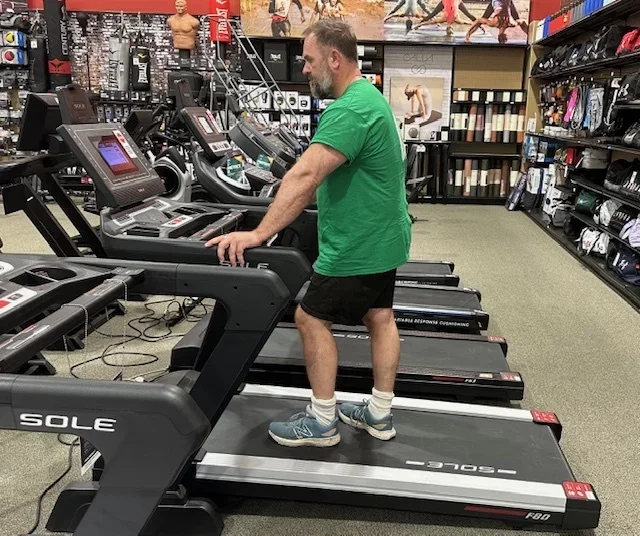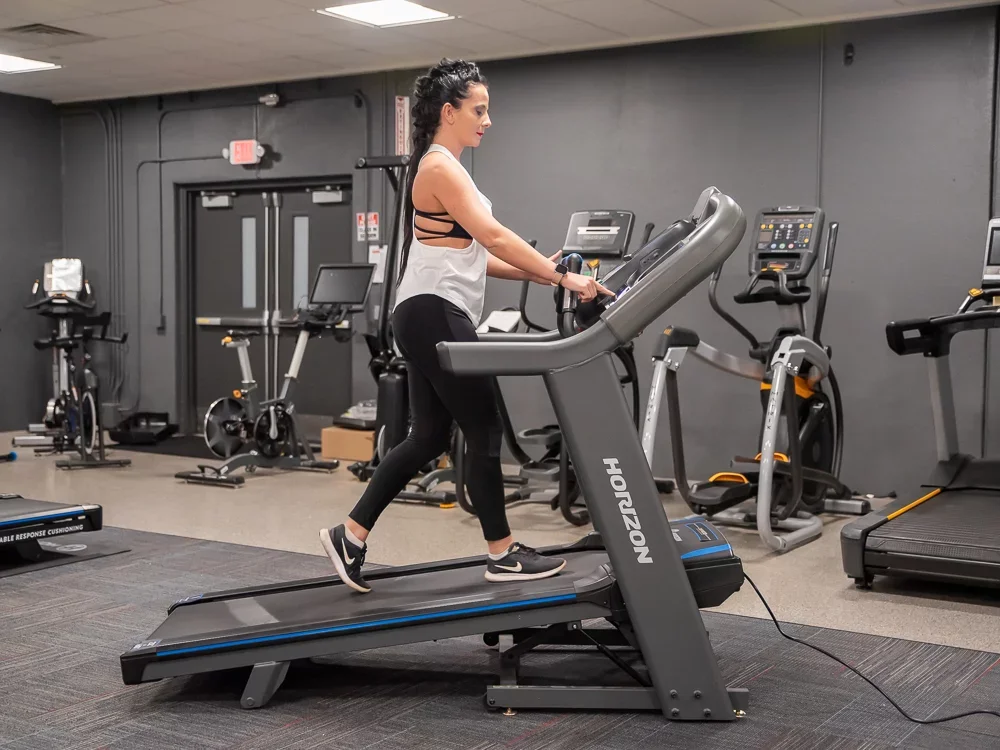My Comparison of the Sole F80 and Horizon 7.4 AT Treadmills
I have to admit, this is a tough one. In comparing the Sole F80 with the Horizon 7.4 AT, you’re looking at two very similar treadmills both designed to offer you a personalized workout experience. Both Horizon and Sole rely on what I call a machine-first philosophy, which emphasizes the quality of the parts from deck to rollers, and then lets you choose whatever workout apps you want. This stands in contrast to the iFit machines like NordicTrack and Peloton which are designed with larger high-definition touchscreens which work with one particular program.
I happen to be a dedicated fan of both brands and have used them myself. My comparison here will cover key features, pros, and cons to help potential buyers make an informed decision. But if you want my answer in two words, here they are – Price and Size. The Horizon model is simply a little smaller and less expensive than the Sole. That’s not insignificant though. The extra six inches in length can make a big difference for some when deciding to place the model, and price is always a factor of course.
Feature Comparison between the Sole F80 and the Horizon 7.4 AT
Here’s the specs side by side for each treadmill:
| Feature | Sole F80 | Horizon 7.4 AT |
|---|---|---|
| Motor | 3.5 CHP | 3.5 CHP |
| Running Surface | 22″ x 60″ | 22″ x 60″ |
| Incline Range | 0-15 levels | 0% to 15% |
| Speed Range | 0.5 – 12 mph | 0.5 – 12 mph |
| Display | 10.1″ LCD | 8.25″ LCD |
| Weight Capacity | 350 lbs | 350 lbs |
| Built-In Programs | 10, 12 user-defined | 10 |
| Folding Mechanism | Easy Assist Folding | FeatherLight Folding |
| Cushioning System | CushionFlex Whisper Deck | 3-Zone Variable Response Cushioning |
| Bluetooth Connectivity | Yes | Yes |
| Dimensions | 82″ L x 38″ W x 66″ H | 76″ L x 37″ W x 63″ H |
| Warranty | Lifetime frame and motor, 3 years deck and parts, 1 years labor | Lifetime frame and motor, 5 years parts, 2 years labor |
| Best Price | Check Best Price | Check Best Price |

I’ve worked on both of these treadmills and have had a good experience with both.
These two treadmills are bound to be compared by customers seeking a $1,500 to $2,000 folding home treadmill. Both models come toward the upper end of their respective brands, but not up in the clouds with the budget-busters blaring all the extras. In terms of pricing, the Sole F80 runs $1,899.99 online against an MSRP of $2,799.99, and the Horizon 7.4 AT is priced at $1,599 with MSRP at $2,399. Both offer financing plans for qualified buyers as well as the occasional holiday sale, but overall, the difference is about $300.
And as you’d expect, with the slightly lower price comes a slightly smaller machine in terms of footprint. The Sole F80, when fully assembled, measures 82.5″ x 38″ x 66″ and weighs 274 pounds. It’s 322 pounds in the box. I had three teenagers help me assemble this machine here at my home and was glad for the assistance. Both companies offer in-home assembly for a fee, but frankly if you have help it’s not rocket science. As a folding treadmill, you can lift up the tail end and close it like a clothing rack for a folded measurement of 44″ x 38″ x 71.5″. The step-up height on this treadmill is 8″ and it can support up to 350 pounds. The LCD screen built to work with this is 10.1″ across.
The Horizon 7.4 AT on the other hand measures 76″ x 37″ x 63″ when fully assembled and weighs 318 pounds. So, it’s a smaller unit, and trust me, that six-inch difference in length can matter in some rooms. But it’s 44 pounds heavier, and that matters if it’s going upstairs with a room below. The shipping weight is 386 pounds, and again, you’ll want help if you plan to assemble this yourself. The folded dimensions are 42″ x 37″ x 71″ and the step-up height is 8.75″. The maximum user weight is 350 pounds. The LCD screen built to work with this treadmill is 8.25″ across.
When you check the rest of the specs, you’ll see, they’re nearly identical. Both offer a 22″ x 60″ running space, lifetime warrantied 3.5 CHP motor, and 2.36″ rollers. As I’ve written in Treadmill Decks and Belts Explained here, the rollers are the steel cylinders at either end of the deck which pull the belt. The market for home treadmills sees roller sizes ranging from 1.5″ to 3″ and as a rule, the bigger the better for smooth operation and motor longevity. Heavier rollers will better keep the belt in alignment and prevent stress from the motor. I’m not surprised both machines offer lifetime warranties on their decks and motors with rollers this size.
In terms of workout programming, both of these models are built with a handy media rack. I’ve used both and have yet to feel much wiggle or wobble when using the machine. You can attach a phone or tablet into the shelf and snap it securely into place there. As Bluetooth treadmills, this allows you to access whatever programming you want with the flip of a switch. Meanwhile, both come with 10 built-in workout programs, with Sole having two extra you can customize. These built-in workouts have yet to disappoint me frankly and yes, they’re pretty much your standard mix of cardio workouts, including intervals, hill climbs, High Intensity Interval Training (HIIT), and manually programmed. The LCD screen provides workout metrics and can sync with a Bluetooth heart rate monitor of your choice.


Both Horizon and Sole afford users a handy media rack above the screen. Brian Boyce and Oleksandr Kosheliev / TreadmilReviews.net
Now, at this point, I have to tell you, if you’re an average cardio fan simply looking for a workout, either one will work. There are some brand-specific differences offered though. The Horizon 7.4 AT is built to sync with Zwift, as well as Peloton and STUDIO. The Sole F80 meanwhile comes built to work with the cost-free Sole+ app. I’ve used all the above and have nothing but positive things to say about them. In my experience, you’ll come to like and use any with equal ability as they provide a virtual library of workouts numbering in the thousands and can be downloaded onto any device and taken with you while you travel. Both treadmills come with a device charger and again, they’re designed to let you use pretty much whatever program you want by way of a separate device.
When it comes to performance, again the two treadmills both feature 0-15 levels of incline and speeds up to 12mph in terms of speed. Since each has a 3.5 CHP motor, you’ll be able to run six or seven days a week on either of these machines without worry. As we point out in our article about treadmill motors here, you’ll see on the home treadmill market anywhere from 2.0 to 4.5 CHP motors, and with each measure comes additional price. For the average athlete a 3.5 CHP motor will do anything you want sufficient to don’t forget to lubricate the belt and keep it clean.
So, at the end of the day, does size matter? With the Sole you’re getting a slightly larger, albeit lighter treadmill, with a larger LCD screen. The cost is difference is about $300. In terms of function and all other things work out-related I’d say they’re exceptionally close rivals. One thing I will say about both the Horizon and Sole brands is their commitment to engineering excellence is manifest in their warranties. Horizon takes pride in its Johnson Digital Drive System’s Rapid Sync Motor which provides up to 500 pounds of thrust on the incline. Sole meanwhile makes some of the best decks in the industry. Both offer in-home placement and assembly for a cost which will vary based on preferences.
Given the specs, what are the pro’s and cons between the two treadmills?

| Sole F80 | Horizon 7.4 AT |
|---|---|
| Pros: | Pros: |
| – Larger 10.1″ LCD screen | – Price of $1,599 |
| – Lighter 274-pound unit | – Better warranty on parts and labor |
| – Larger 82.5″ x 38″ x 66″ frame | – Heavier 318-pound unit |
| – 10 built-in programs, 12 user-defined | – Smaller 76″ x 37″ x 63″ frame |
| Cons: | Cons: |
| – Price of 1,899.99 | – Two fewer built-in programs |
| – Larger frame be an issue for some | – Smaller 8.25″ LCD screen |
| – Lighter frame may be an issue for some | – Heavier frame may be an issue for some |

The Sole F80 does has an incline up to 15 levels.
A More Detailed Comparison
Motor and Performance
Both the Sole F80 and Horizon 7.4 AT treadmills are equipped with a 3.5 CHP motor. Both of these motors will offer vigorous performance suitable for a range of users, from walkers to serious runners. As we outline in our piece here, Treadmill Motors: What You Need to Know, a 3.5 CHP is sufficient for running at speeds over 6mph multiple times per week. In my own experience, both Sole and Horizon produce a top-flight motor and I’ve never had a problem with either.
Running Surface
Both the Sole F80 and Horizon 7.4 AT feature a spacious 22″ x 60″ running surface, and both offer 2.36″ rollers, as well as a 2-ply belt.
Incline and Speed Range
Both treadmills offer inclines of 0-15 levels. Both models have a speed range of 0.5 to 12 mph.
Display and Programs
The Sole F80 has a 10.1″ HD touchscreen, while the Horizon 7.4 AT sports an 8.25″ model. Both units offer Bluetooth speakers and integration with heart rate monitors, as well as built-in workouts and function with cost-free apps.
Cushioning and Folding Mechanism
Both treadmills feature effective cushioning systems designed to reduce impact on joints. The Sole F80 uses the CushionFlex Whisper Deck, and the Horizon 7.4 AT features a 3-Zone Variable Response Cushioning. Both models offer convenient folding mechanisms; the F80 with its Easy Assist Folding and the 7.4 AT with its FeatherLight Folding Design.
Additional Features
Both treadmills come with Bluetooth connectivity for easy syncing with fitness apps and devices. As well as media racks and audio plug-ins.
Warranty and Dimensions
The Sole F80 offers a more comprehensive warranty with lifetime coverage on the frame and motor, 3 years on parts and deck, and 1 year on labor. In contrast, the Horizon 7.4 AT provides lifetime coverage on the frame and motor, as well as 5 years on parts and 2 years for labor.
Which would I recommend? They are both great treadmills!
This one simply comes down to price and size. Yes, they’re close. For a little more money you can have a larger model with a 10.1″ screen as opposed to smaller, but heavier treadmill with an 8.25″ screen. In terms of performance, I’d say it’s pretty equal. The smaller Horizon 7.4 AT will wheel about easier in a smaller room, and while the extra weight won’t matter in terms of movement, it might if you put it in a second-story bedroom. That said, $300 is $300, and that’s the difference in price.

